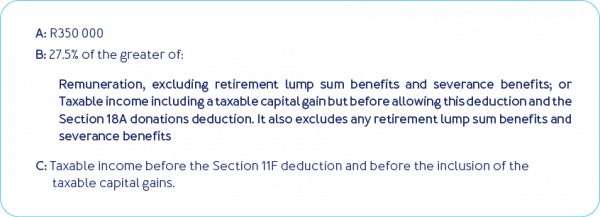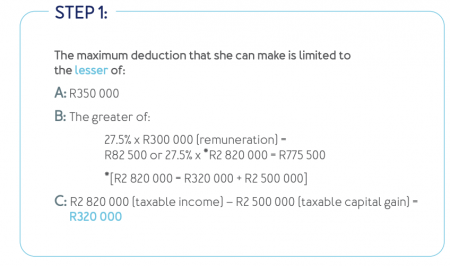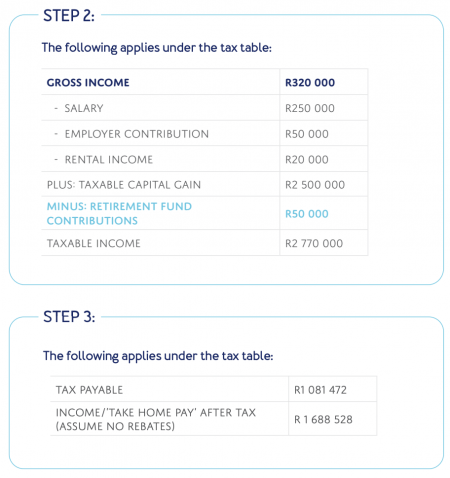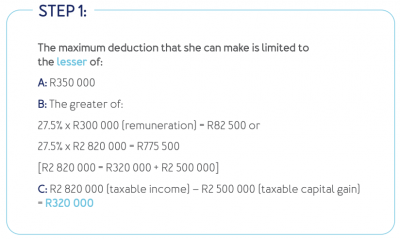Practice Notes
The Impact of CGT on Your Retirement Savings Deduction

This article focuses on Section 11F of the Income Tax Act, which relates to the deduction of contributions to retirement funds. We discuss the impact of Capital Gains Tax (CGT) when calculating the amount you are able to deduct for tax purposes.
Review – three limitations to be considered
The amount of the deduction in a particular year of assessment is limited by Section 11F to the lesser (smaller) of A, B and C below.

‘Taxable income’ vs. taxable income – be mindful of the context in which the words are used.
Taxable income is used to determine the maximum amount you can deduct for tax purposes for retirement contributions. However, you need to be cautious when applying Section 11F as SARS uses the words taxable income in two instances, which can create confusion. (1) For determining the maximum amount you can deduct for tax purposes for retirement contributions, and (2) to determine your final tax liability.
The following examples illustrate the above application The calculation is a three-step process:
- Calculate your retirement fund deduction by applying Section 11F
- Add your taxable capital gain to calculate your taxable income
- Apply the tax tables to determine your tax liability
Example 1: R50 000 contribution Mrs Selinda earns an annual salary of R250 000 Her employer contributed 20% (i.e. R50 000) to a pension fund on her behalf She also earned rental income of R20 000 (no expenses incurred) She incurred a taxable capital gain of R2 500 000 after selling shares from the portfolio she inherited from her late father.

The deduction will be limited to the lesser of the three amounts in bold, which is R320 000. Mrs Selinda only contributed R50 000 and therefore can deduct the full amount of R50 000 for tax purposes.
To the extent that a taxable capital gain is included in taxable income, it will increase the potential deduction, thus ‘saving more tax’ for that year of tax assessment.

Example 2: Retirement fund contribution of R350 000
Mrs Selinda decided to increase her pension contribution to R350 000 for this year of tax assessment to ‘get the full tax benefit’ now that she has incurred a taxable capital gain of R2 500 000. She used R300 000 from the sale of shares from her equity portfolio to make a voluntary contribution towards a retirement annuity (RA). The total contribution is therefore R350 000 (R50 000 contribution from her employer and R300 000 voluntary contribution).

The deduction will be limited to the lesser of the three amounts in bold, which is R320 000. Mrs. Selinda contributed R350 000 BUT is now limited to deducting only R320 000 for tax purposes.
Taxable capital gain included but your deduction is limited to ‘taxable income’ only.

Dispelling the myth that your retirement contributions can reduce your tax on capital gains
Confusion exists among investors because taxable income, as defined in Section 11F, includes taxable capital gains. However, if you look at the limitations i.e. part C, the retirement savings deduction is reduced to taxable income before the taxable capital gain is added. In other words, your taxable capital gain is therefore still fully taxable – as illustrated per the above examples – and does not reduce the tax on capital gains.
Your taxable capital gain (and the eventual tax arising from it) cannot be eliminated or reduced by the deduction under Section 11F for retirement contributions.
Summary
SARS uses the words ‘taxable income’ in two instances. This can create misunderstanding and ultimately, the miscalculation of deductible contributions – ‘taxable income’ for retirement contribution deductions and taxable income to calculate your final tax payable.
The taxable capital gain is included in Section 11F, BUT your deduction limited to ‘taxable income’ only. Therefore, if you wish to make a larger retirement contribution in a year where you also have a large taxable capital gain, first apply Section 11F to assess the maximum amount you can deduct, before deciding on what your voluntary contribution should be to achieve the maximum tax saving.
INN8 Invest is not a tax professional. Please seek the appropriate assistance/advice from a qualified financial or tax adviser.
Key Points:
• The inclusion of the taxable capital gain in Section 11F of the Income Tax Act, presents the opportunity to allocate a larger contribution to retirement funds (i.e. tax saving) for that year of assessment.
• However, your retirement savings deduction is reduced to taxable income before the taxable capital gain is added. In other words, your taxable capital gain is still fully taxable. This dispells the myth that retirement contributions can reduce your tax on capital gains.
Knowledge is Power…
Access more insights from the INN8 Invest team’s quarterly report.
For you, the adviser, click below to download a collection of articles to use in your practice.
